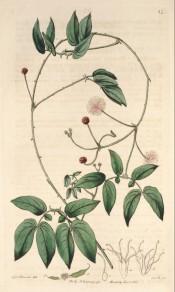Mimosa sensitiva L.
A frost-tender, prickly, semi-climbing, evergreen shrub with sensitive stems and leaves composed of 2 unequal pinnae, and purple flowers in summer. Sensitive to touch. To 2m. [RHSD].
Horticultural & Botanical History
‘The appellation of “the sensitive plant” having long since been generally transferred in our gardens from the present species [Mimosa sensitiva L.] to the Mimosa pudica or “humble plant”, a small annual that occurs in almost every collection, where tender annuals are cultivated; this article may serve to recall to our readers the original owner of that name; a plant rarely seen in this country.
The extraordinary effect of the perceptibility of the present and other Mimosas, has given rise to much speculation among physiologists, which however appears to have afforded no satisfactory or very interesting result. It is certain that when this plant is in health and growing in a sufficient degree of warmth, the leaves, upon being smartly touched, fold together by their leaflets, and their stalk sinks; the same change of position takes place spontaneously in them all every evening for the night; and the posture then assumed is, according to Linnaus, that of the sleep of the plant. A leaf that has collapsed either naturally or from artificial irritation, is perceived to resume its extended state by a gradual vibratory motion, compared by Miller to that of the index of a clock. The discovery of the end attained in this phenomenon is most probably reserved for a diligent attention to the economy of these vegetables on their native spot. The root of all of them emits a most offensive smell, resembling that from a sewer at the time of impending rain.
The species is marked in the Hortus Kewensis for biennial. Its stem is woody and brittle, and sometimes acquires the height of 8 feet; but must have support. Several new ones have been discovered in South America (of which country all are natives), by Messrs. Bonpland and Humboldt. Native of the Brazils. Introduced in 1733 by Dr. Houston.’ [BR f. 25/1815].
History at Camden Park
Listed only in the 1857 catalogue [T.684/1857].
Notes
‘This sensitive plant [Mimosa sensitiva] is said to have been cultivated in the Oxford garden in 1648. It rises with a slender shrubby stem to the height of three or four feet, with loose pendulous branches, from the ends of which, for six inches or more in length, the flowers are produced in several heads.’ [LBC no.249/1818]. The plant figured in the Botanical Cabinet is said to be Mimosa albida Humb. & Bonpl. ex Willd. although I have been unable to confirm this. If so it could well be the plant obtained by Macarthur. It is a tender spiny shrub with grey, pubescent stems and foliage and pinkish flowers. To 3m. [Hortus].
Mimosa pudica L. is even more sensitive than Mimosa sensitiva and is often mistaken for it.
Published Dec 23, 2009 - 05:05 PM | Last updated Jul 21, 2010 - 12:35 PM
| Family | Fabaceae |
|---|---|
| Category | |
| Region of origin | Tropical America |
| Synonyms | |
| Common Name | Sensitive Plant |
| Name in the Camden Park Record |
Mimosa sensitiva |
| Confidence level | medium |


